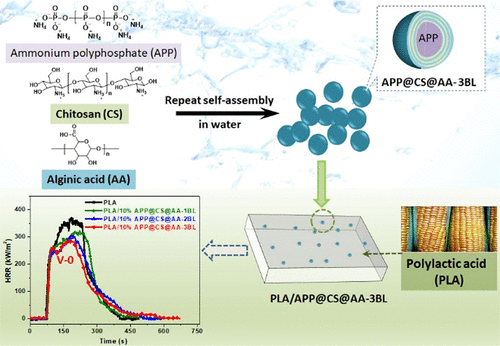当前位置:
X-MOL 学术
›
ACS Sustain. Chem. Eng.
›
论文详情
Our official English website, www.x-mol.net, welcomes your
feedback! (Note: you will need to create a separate account there.)
Core–Shell Bioderived Flame Retardants Based on Chitosan/Alginate Coated Ammonia Polyphosphate for Enhancing Flame Retardancy of Polylactic Acid
ACS Sustainable Chemistry & Engineering ( IF 7.1 ) Pub Date : 2020-03-31 , DOI: 10.1021/acssuschemeng.0c00634 Yan Zhang 1 , Zhengquan Xiong 1 , Haodong Ge 1 , Leikun Ni 1 , Tao Zhang 2 , Siqi Huo 3 , Pingan Song 3 , Zhengping Fang 1
ACS Sustainable Chemistry & Engineering ( IF 7.1 ) Pub Date : 2020-03-31 , DOI: 10.1021/acssuschemeng.0c00634 Yan Zhang 1 , Zhengquan Xiong 1 , Haodong Ge 1 , Leikun Ni 1 , Tao Zhang 2 , Siqi Huo 3 , Pingan Song 3 , Zhengping Fang 1
Affiliation

|
Bioderived flame retardants represent one class of the most promising sustainable additives for creating flame retardant polylactic acid (PLA) because of their marginal impact on the biodegradability of PLA. Ammonium polyphosphate (APP) has demonstrated high flame-retardant effectiveness in PLA but its flame-retardant efficiency remains unsatisfactory even if after modifications. Herein, we report the facile fabrication of core–shell bioderived flame retardants by using APP as the core, and the chitosan (CS)/alginate (AA) bilayer as the shell through self-assembly in aqueous solution. The resultant core–shell flame retardant, APP@CS@AA-nBL (where “BL” is a CS&AA bilayer and “n” denotes 1–3 BL), can endow PLA with improved flame retardancy without negatively affecting the thermal properties. The PLA containing 10 wt % APP@CS@AA-3BL shows the highest LOI value (30.6%) and achieves a UL94 V-0 rating in the vertical burning test. Meanwhile, the cone calorimetry results demonstrate that the peak of the heat release rate and total heat release are respectively decreased by 23% and 11% relative to the PLA bulk. Such enhanced flame retardancy is mainly due to the excellent char-forming capability of APP@CS@AA. Moreover, the inclusion of 10 wt % APP@CS@AA-3BL gives rise to ∼23% increase in the impact strength of PLA possibly because of their interfacial hydrogen-bonding interactions. This work provides a facile and green strategy for preparing highly effective bioderived flame retardants for PLA and thus is expected to expand the practical applications in industry.
中文翻译:

基于壳聚糖/藻酸酯包衣的聚磷酸氨的核壳生物衍生阻燃剂,可增强聚乳酸的阻燃性
生物衍生的阻燃剂代表一类最有希望的可持续发展添加剂,可用于创建阻燃剂聚乳酸(PLA),因为它们对PLA的生物降解性有边际影响。聚磷酸铵(APP)在PLA中显示出很高的阻燃效果,但即使经过改性,其阻燃效率仍然不能令人满意。本文中,我们报道了通过使用APP作为核,并通过在水溶液中自组装将壳聚糖(CS)/藻酸盐(AA)双层作为壳,轻松制造核-壳生物衍生的阻燃剂。最终的核壳型阻燃剂APP @ CS @ AA-nBL(其中“ BL”是CS&AA双层,“ n”表示1-3 BL)可以使PLA的阻燃性得到改善,而不会对热性能产生负面影响。包含10 wt%APP @ CS @ AA-3BL的PLA显示出最高的LOI值(30.6%),并且在垂直燃烧测试中达到UL94 V-0等级。同时,锥形量热法结果表明,相对于PLA体积,放热率和总放热的峰值分别降低了23%和11%。这种增强的阻燃性主要是由于APP @ CS @ AA具有出色的成炭能力。此外,包含10 wt%的APP @ CS @ AA-3BL可能会使PLA的冲击强度提高约23%,这可能是由于它们之间存在界面氢键相互作用。这项工作为制备用于PLA的高效生物衍生阻燃剂提供了简便而绿色的策略,因此有望扩大工业上的实际应用。6%),并在垂直燃烧测试中达到UL94 V-0等级。同时,锥形量热法结果表明,相对于PLA体积,放热率和总放热的峰值分别降低了23%和11%。这种增强的阻燃性主要是由于APP @ CS @ AA具有出色的成炭能力。此外,包含10 wt%的APP @ CS @ AA-3BL可能会使PLA的冲击强度提高约23%,这可能是由于它们之间存在界面氢键相互作用。这项工作为制备用于PLA的高效生物衍生阻燃剂提供了简便而绿色的策略,因此有望扩大工业上的实际应用。6%),并在垂直燃烧测试中达到UL94 V-0等级。同时,锥形量热法的结果表明,放热率和总放热的峰值相对于PLA体积分别降低了23%和11%。这种增强的阻燃性主要是由于APP @ CS @ AA具有出色的成炭能力。此外,包含10 wt%的APP @ CS @ AA-3BL可能会使PLA的冲击强度提高约23%,这可能是由于它们之间存在界面氢键相互作用。这项工作为制备用于PLA的高效生物衍生阻燃剂提供了简便而绿色的策略,因此有望扩大工业上的实际应用。锥形量热法结果表明,相对于PLA体积,放热率和总放热峰分别降低了23%和11%。这种增强的阻燃性主要是由于APP @ CS @ AA具有出色的成炭能力。此外,包含10 wt%的APP @ CS @ AA-3BL可能会使PLA的冲击强度提高约23%,这可能是由于它们之间存在界面氢键相互作用。这项工作为制备用于PLA的高效生物衍生阻燃剂提供了简便而绿色的策略,因此有望扩大工业上的实际应用。锥形量热法结果表明,相对于PLA体积,放热率和总放热峰分别降低了23%和11%。这种增强的阻燃性主要是由于APP @ CS @ AA具有出色的成炭能力。此外,包含10 wt%的APP @ CS @ AA-3BL可能会使PLA的冲击强度提高约23%,这可能是由于它们之间存在界面氢键相互作用。这项工作为制备用于PLA的高效生物衍生阻燃剂提供了简便而绿色的策略,因此有望扩大工业上的实际应用。包含10 wt%的APP @ CS @ AA-3BL可能会使PLA的冲击强度提高约23%,这可能是因为它们之间存在界面氢键相互作用。这项工作为制备用于PLA的高效生物衍生阻燃剂提供了简便而绿色的策略,因此有望扩大工业上的实际应用。包含10 wt%的APP @ CS @ AA-3BL可能会使PLA的冲击强度提高约23%,这可能是因为它们之间存在界面氢键相互作用。这项工作为制备用于PLA的高效生物衍生阻燃剂提供了简便而绿色的策略,因此有望扩大工业上的实际应用。
更新日期:2020-03-31
中文翻译:

基于壳聚糖/藻酸酯包衣的聚磷酸氨的核壳生物衍生阻燃剂,可增强聚乳酸的阻燃性
生物衍生的阻燃剂代表一类最有希望的可持续发展添加剂,可用于创建阻燃剂聚乳酸(PLA),因为它们对PLA的生物降解性有边际影响。聚磷酸铵(APP)在PLA中显示出很高的阻燃效果,但即使经过改性,其阻燃效率仍然不能令人满意。本文中,我们报道了通过使用APP作为核,并通过在水溶液中自组装将壳聚糖(CS)/藻酸盐(AA)双层作为壳,轻松制造核-壳生物衍生的阻燃剂。最终的核壳型阻燃剂APP @ CS @ AA-nBL(其中“ BL”是CS&AA双层,“ n”表示1-3 BL)可以使PLA的阻燃性得到改善,而不会对热性能产生负面影响。包含10 wt%APP @ CS @ AA-3BL的PLA显示出最高的LOI值(30.6%),并且在垂直燃烧测试中达到UL94 V-0等级。同时,锥形量热法结果表明,相对于PLA体积,放热率和总放热的峰值分别降低了23%和11%。这种增强的阻燃性主要是由于APP @ CS @ AA具有出色的成炭能力。此外,包含10 wt%的APP @ CS @ AA-3BL可能会使PLA的冲击强度提高约23%,这可能是由于它们之间存在界面氢键相互作用。这项工作为制备用于PLA的高效生物衍生阻燃剂提供了简便而绿色的策略,因此有望扩大工业上的实际应用。6%),并在垂直燃烧测试中达到UL94 V-0等级。同时,锥形量热法结果表明,相对于PLA体积,放热率和总放热的峰值分别降低了23%和11%。这种增强的阻燃性主要是由于APP @ CS @ AA具有出色的成炭能力。此外,包含10 wt%的APP @ CS @ AA-3BL可能会使PLA的冲击强度提高约23%,这可能是由于它们之间存在界面氢键相互作用。这项工作为制备用于PLA的高效生物衍生阻燃剂提供了简便而绿色的策略,因此有望扩大工业上的实际应用。6%),并在垂直燃烧测试中达到UL94 V-0等级。同时,锥形量热法的结果表明,放热率和总放热的峰值相对于PLA体积分别降低了23%和11%。这种增强的阻燃性主要是由于APP @ CS @ AA具有出色的成炭能力。此外,包含10 wt%的APP @ CS @ AA-3BL可能会使PLA的冲击强度提高约23%,这可能是由于它们之间存在界面氢键相互作用。这项工作为制备用于PLA的高效生物衍生阻燃剂提供了简便而绿色的策略,因此有望扩大工业上的实际应用。锥形量热法结果表明,相对于PLA体积,放热率和总放热峰分别降低了23%和11%。这种增强的阻燃性主要是由于APP @ CS @ AA具有出色的成炭能力。此外,包含10 wt%的APP @ CS @ AA-3BL可能会使PLA的冲击强度提高约23%,这可能是由于它们之间存在界面氢键相互作用。这项工作为制备用于PLA的高效生物衍生阻燃剂提供了简便而绿色的策略,因此有望扩大工业上的实际应用。锥形量热法结果表明,相对于PLA体积,放热率和总放热峰分别降低了23%和11%。这种增强的阻燃性主要是由于APP @ CS @ AA具有出色的成炭能力。此外,包含10 wt%的APP @ CS @ AA-3BL可能会使PLA的冲击强度提高约23%,这可能是由于它们之间存在界面氢键相互作用。这项工作为制备用于PLA的高效生物衍生阻燃剂提供了简便而绿色的策略,因此有望扩大工业上的实际应用。包含10 wt%的APP @ CS @ AA-3BL可能会使PLA的冲击强度提高约23%,这可能是因为它们之间存在界面氢键相互作用。这项工作为制备用于PLA的高效生物衍生阻燃剂提供了简便而绿色的策略,因此有望扩大工业上的实际应用。包含10 wt%的APP @ CS @ AA-3BL可能会使PLA的冲击强度提高约23%,这可能是因为它们之间存在界面氢键相互作用。这项工作为制备用于PLA的高效生物衍生阻燃剂提供了简便而绿色的策略,因此有望扩大工业上的实际应用。











































 京公网安备 11010802027423号
京公网安备 11010802027423号